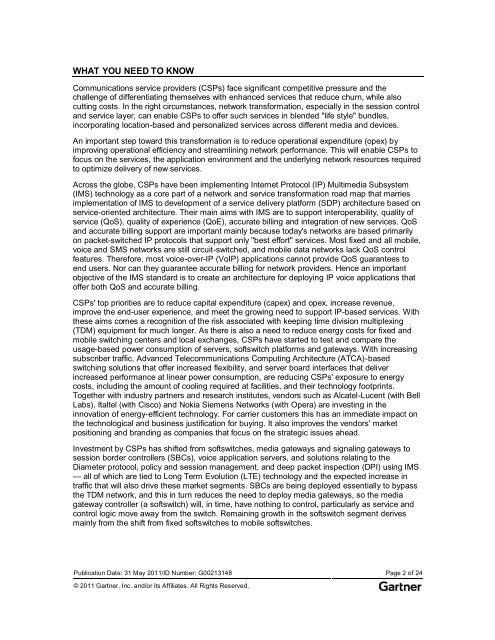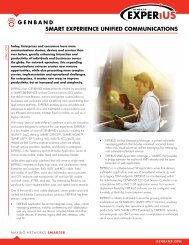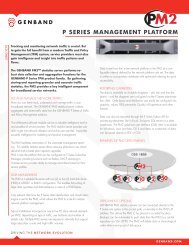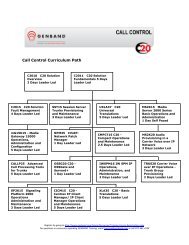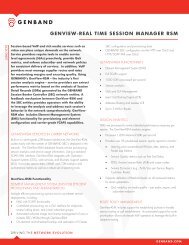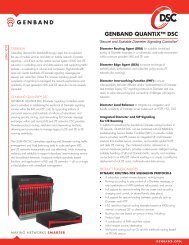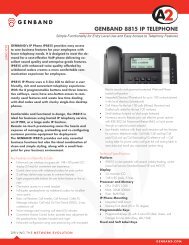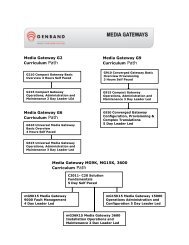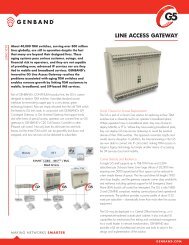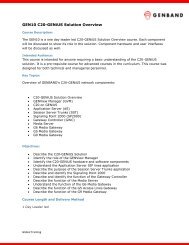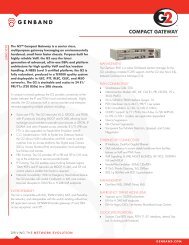Research Magic Quadrant for Softswitch Architecture - Genband
Research Magic Quadrant for Softswitch Architecture - Genband
Research Magic Quadrant for Softswitch Architecture - Genband
Create successful ePaper yourself
Turn your PDF publications into a flip-book with our unique Google optimized e-Paper software.
WHAT YOU NEED TO KNOW<br />
Communications service providers (CSPs) face significant competitive pressure and the<br />
challenge of differentiating themselves with enhanced services that reduce churn, while also<br />
cutting costs. In the right circumstances, network trans<strong>for</strong>mation, especially in the session control<br />
and service layer, can enable CSPs to offer such services in blended "life style" bundles,<br />
incorporating location-based and personalized services across different media and devices.<br />
An important step toward this trans<strong>for</strong>mation is to reduce operational expenditure (opex) by<br />
improving operational efficiency and streamlining network per<strong>for</strong>mance. This will enable CSPs to<br />
focus on the services, the application environment and the underlying network resources required<br />
to optimize delivery of new services.<br />
Across the globe, CSPs have been implementing Internet Protocol (IP) Multimedia Subsystem<br />
(IMS) technology as a core part of a network and service trans<strong>for</strong>mation road map that marries<br />
implementation of IMS to development of a service delivery plat<strong>for</strong>m (SDP) architecture based on<br />
service-oriented architecture. Their main aims with IMS are to support interoperability, quality of<br />
service (QoS), quality of experience (QoE), accurate billing and integration of new services. QoS<br />
and accurate billing support are important mainly because today's networks are based primarily<br />
on packet-switched IP protocols that support only "best ef<strong>for</strong>t" services. Most fixed and all mobile,<br />
voice and SMS networks are still circuit-switched, and mobile data networks lack QoS control<br />
features. There<strong>for</strong>e, most voice-over-IP (VoIP) applications cannot provide QoS guarantees to<br />
end users. Nor can they guarantee accurate billing <strong>for</strong> network providers. Hence an important<br />
objective of the IMS standard is to create an architecture <strong>for</strong> deploying IP voice applications that<br />
offer both QoS and accurate billing.<br />
CSPs' top priorities are to reduce capital expenditure (capex) and opex, increase revenue,<br />
improve the end-user experience, and meet the growing need to support IP-based services. With<br />
these aims comes a recognition of the risk associated with keeping time division multiplexing<br />
(TDM) equipment <strong>for</strong> much longer. As there is also a need to reduce energy costs <strong>for</strong> fixed and<br />
mobile switching centers and local exchanges, CSPs have started to test and compare the<br />
usage-based power consumption of servers, softswitch plat<strong>for</strong>ms and gateways. With increasing<br />
subscriber traffic, Advanced Telecommunications Computing <strong>Architecture</strong> (ATCA)-based<br />
switching solutions that offer increased flexibility, and server board interfaces that deliver<br />
increased per<strong>for</strong>mance at linear power consumption, are reducing CSPs' exposure to energy<br />
costs, including the amount of cooling required at facilities, and their technology footprints.<br />
Together with industry partners and research institutes, vendors such as Alcatel-Lucent (with Bell<br />
Labs), Italtel (with Cisco) and Nokia Siemens Networks (with Opera) are investing in the<br />
innovation of energy-efficient technology. For carrier customers this has an immediate impact on<br />
the technological and business justification <strong>for</strong> buying. It also improves the vendors' market<br />
positioning and branding as companies that focus on the strategic issues ahead.<br />
Investment by CSPs has shifted from softswitches, media gateways and signaling gateways to<br />
session border controllers (SBCs), voice application servers, and solutions relating to the<br />
Diameter protocol, policy and session management, and deep packet inspection (DPI) using IMS<br />
— all of which are tied to Long Term Evolution (LTE) technology and the expected increase in<br />
traffic that will also drive these market segments. SBCs are being deployed essentially to bypass<br />
the TDM network, and this in turn reduces the need to deploy media gateways, so the media<br />
gateway controller (a softswitch) will, in time, have nothing to control, particularly as service and<br />
control logic move away from the switch. Remaining growth in the softswitch segment derives<br />
mainly from the shift from fixed softswitches to mobile softswitches.<br />
Publication Date: 31 May 2011/ID Number: G00213148 Page 2 of 24<br />
© 2011 Gartner, Inc. and/or its Affiliates. All Rights Reserved.


